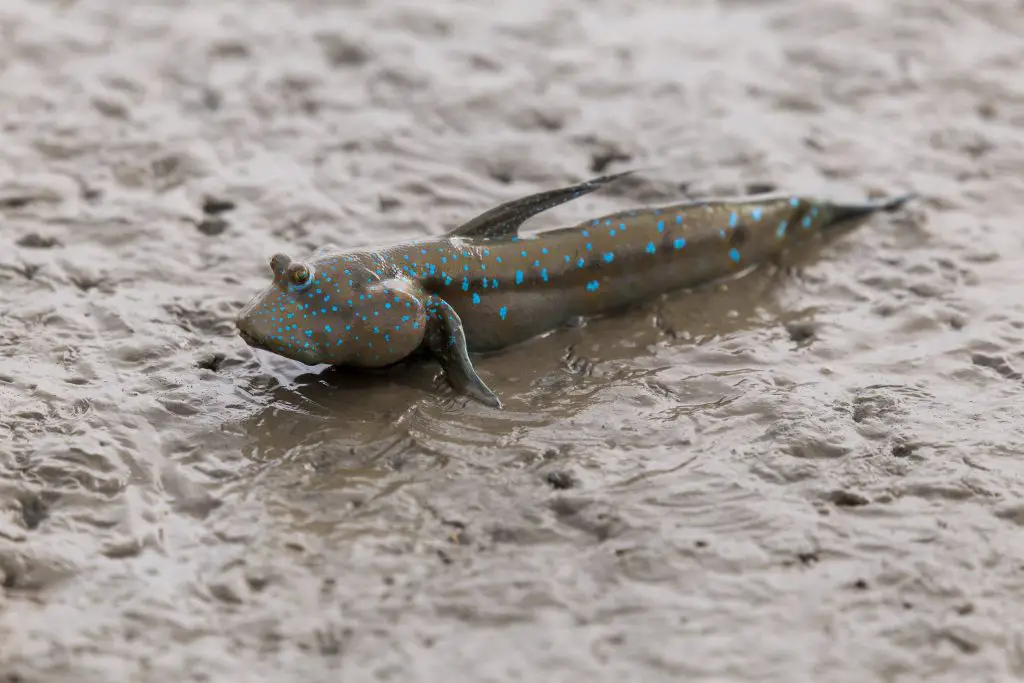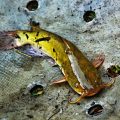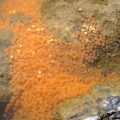Catfish can survive in puddles of mud. This is because their body stays protected by wet mud, mucus, and slime. They breathe with a process known as cutaneous respiration. Catfish can be seen to enclose themselves in mud, cover themselves in a mucus slime, and remain suspended for a whole year or more, taking oxygen via the permeable skin that helps for this specific purpose of survival. Their metabolism slows down, and they can get a bit of oxygen from outside. This bit of oxygen is enough for them to survive as they can live with extremely low oxygen levels, if they were in an extreme drought situation.

Can a Catfish Live Out of Water?
Catfish are some of the more unique fish out there when it comes to different types of fish. It is not just because of their appearance but also because they have a unique ability to breathe out of the water, at least to a certain extent. They have a special organ known as the suprabranchial organ. For which they can live out of water for up to 15 or even 18 hours, but conditions do apply. They might survive longer if they are kept in an open bowl with little water, and their skin stays moist, but they cannot live out of water permanently. For instance, some catfish may not make it past an hour out of the water, while others can last for nearly a day. It is important for them to get back in the water again as soon as possible to survive.
Why Do Catfish Bury in Mud?
Catfish love concealed areas and it’s not astonishing to know that they love burrowing in the mud. Catfish burrow in mud for two reasons. First, catfish burrow in mud for safer and darker areas out of the heat. Secondly, catfish burrow in mud to nest their eggs and keep them safe from scavenging predators. The female catfish needs an enclosed area to lay her eggs. The female catfish is smart enough to understand that if she doesn’t lay her eggs in a hidden area, she could lose them to predators. The female catfish often burrows in mud to lay her eggs and keep them safe after having mated. Catfish can withstand harsh conditions. They can also survive drought, and they have the unique ability to breathe in and out of water. They are very strong.
Do Catfish Live in Mud?
Catfish are one of those fish that hide. They don’t like the spotlight. They are aware of how they pick their habitat, making it easy to hide. Catfish have several habitats. They can be found in holes, structures, rocks, and mud, but their favorite habitat is mud. They burrow their way in the mud and stay there. Catfish can reside in the mud for a year or so, especially during drought. The mud is the ideal resting spot for them, and it helps conceal them from their predators.
Can Catfish Live on Land?
Walking catfish, as its name advocates, can move efficiently on land. It can cover up to 1.2 kilometers and can survive up to 18 hours out of water. The walking catfish is a species of freshwater airbreathing catfish native to Southeast Asia. It is named because of its ability to “walk” and wiggle across dry land to find food or suitable environments. While it does not walk as most bipeds or quadrupeds do, it can use its pectoral fins to keep it upright as it makes a wiggling motion that can be a snakelike movement to traverse on land.
This kind of catfish can be found in places that may dry up, such as stagnant waters in ponds, swamps, the river, and places like flooded rice paddies or temporary ponds. Its “walking” skill allows the catfish to move to other aquatic environments when this occurs. As catfish are frequently confused with other close relatives, considerable taxonomic confusion surrounds this species. One main difference between the walking catfish and the native North American ictalurid catfish is that it sometimes is confused because the walking catfish lacks an adipose fin.
Why is Mud the Catfish’s Favorite Habitat?
Mud catfish are also known as flathead, yellow, pied, Mississippi and shovelhead catfish. Pylodictis olivaris is the scientific name given to catfish of this type. In Greek, Pylodictis means “mudfish,” while olivaris translates to “olive-colored.” One of its nicknames suggests that this catfish has a flat-shaped head and smooth, scaleless skin. Like most catfish species, whisker-like barbels surround the mouth of the mud catfish. Mud catfish can grow in length to 3 to 4 feet and can weigh more than 100 lbs.
The preferred habitat of mud catfish is deep pools of lakes, rivers, streams, canals, and reservoirs, especially where the water current is slow with a cloudy or turbid quality. They span from the Lower Great Lakes to the Mississippi River watershed. Mud catfish usually feed on crayfish, worms, insects, shad, sunfish, carp, and largemouth bass. Turtles, water snakes, alligators, larger fishes, and humans are some of their predators. During their spawning session, Anglers are most successful in catching mud catfish when the water temperature is between 75 and 80 degrees Fahrenheit.
Some kinds of catfish can tolerate low-oxygen, high-carbon dioxide and acidic muddy bottom waters. They rarely swim up to the surface of the water, preferring the murky bottom, where they can “breathe” through their skin. Channel catfish prefer clear running rivers and streams as they cannot tolerate oxygen-poor waters.
In conclusion, catfish are a very well-known fish found on all continents except Antarctica. They are named catfish, which refers to the long barbels, or feelers, which are present about the mouth of the fish and resemble cat whiskers. Catfish have many unique features that help them thrive in different habitats and water conditions. They have sharp teeth that are incredibly tiny and dense. Catfish can detect their prey as they can use their sense of smell to detect their prey even in low visibility. This increases their rate of survival in the wild.












Pingback: Do Catfish Like Cinnamon? | Reel Fishing Guru
Pingback: Can You Eat Saltwater Catfish? | Reel Fishing Guru